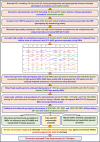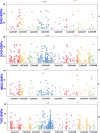Genome-wide generation and genotyping of informative SNPs to scan molecular signatures for seed yield in chickpea
- PMID: 30185866
- PMCID: PMC6125345
- DOI: 10.1038/s41598-018-29926-1
Genome-wide generation and genotyping of informative SNPs to scan molecular signatures for seed yield in chickpea
Abstract
We discovered 2150 desi and 2199 kabuli accessions-derived SNPs by cultivar-wise individual assembling of sequence-reads generated through genotyping-by-sequencing of 92 chickpea accessions. Subsequent large-scale validation and genotyping of these SNPs discovered 619 desi accessions-derived (DAD) SNPs, 531 kabuli accessions-derived (KAD) SNPs, 884 multiple accessions-derived (MAD) SNPs and 1083 two accessions (desi ICC 4958 and kabuli CDC Frontier)-derived (TAD) SNPs that were mapped on eight chromosomes. These informative SNPs were annotated in coding/non-coding regulatory sequence components of genes. The MAD-SNPs were efficient to detect high intra-specific polymorphic potential and wide natural allelic diversity level including high-resolution admixed-population genetic structure and precise phylogenetic relationship among 291 desi and kabuli accessions. This signifies their effectiveness in introgression breeding and varietal improvement studies targeting useful agronomic traits of chickpea. Six trait-associated genes with SNPs including quantitative trait nucleotides (QTNs) in combination explained 27.5% phenotypic variation for seed yield per plant (SYP). A pentatricopeptide repeat (PPR) gene with a synonymous-coding SNP/QTN significantly associated with SYP trait was found most-promising in chickpea. The essential information delineated can be of immense utility in genomics-assisted breeding applications to develop high-yielding chickpea cultivars.
Conflict of interest statement
The authors declare no competing interests.
Figures





Similar articles
-
Integrating genomics for chickpea improvement: achievements and opportunities.Theor Appl Genet. 2020 May;133(5):1703-1720. doi: 10.1007/s00122-020-03584-2. Epub 2020 Apr 6. Theor Appl Genet. 2020. PMID: 32253478 Free PMC article. Review.
-
Genome-wide development and deployment of informative intron-spanning and intron-length polymorphism markers for genomics-assisted breeding applications in chickpea.Plant Sci. 2016 Nov;252:374-387. doi: 10.1016/j.plantsci.2016.08.013. Epub 2016 Aug 25. Plant Sci. 2016. PMID: 27717474
-
Genetic dissection of plant growth habit in chickpea.Funct Integr Genomics. 2017 Nov;17(6):711-723. doi: 10.1007/s10142-017-0566-8. Epub 2017 Jun 9. Funct Integr Genomics. 2017. PMID: 28600722
-
Employing genome-wide SNP discovery and genotyping strategy to extrapolate the natural allelic diversity and domestication patterns in chickpea.Front Plant Sci. 2015 Mar 31;6:162. doi: 10.3389/fpls.2015.00162. eCollection 2015. Front Plant Sci. 2015. PMID: 25873920 Free PMC article.
-
Advances in genetics and molecular breeding of three legume crops of semi-arid tropics using next-generation sequencing and high-throughput genotyping technologies.J Biosci. 2012 Nov;37(5):811-20. doi: 10.1007/s12038-012-9228-0. J Biosci. 2012. PMID: 23107917 Review.
Cited by
-
Integrating genomics for chickpea improvement: achievements and opportunities.Theor Appl Genet. 2020 May;133(5):1703-1720. doi: 10.1007/s00122-020-03584-2. Epub 2020 Apr 6. Theor Appl Genet. 2020. PMID: 32253478 Free PMC article. Review.
-
Genetic diversity, population structure, and genome-wide association study for the flowering trait in a diverse panel of 428 moth bean (Vigna aconitifolia) accessions using genotyping by sequencing.BMC Plant Biol. 2023 Apr 29;23(1):228. doi: 10.1186/s12870-023-04215-w. BMC Plant Biol. 2023. PMID: 37120525 Free PMC article.
-
Genome-Wide Association Analysis for Phosphorus Use Efficiency Traits in Mungbean (Vigna radiata L. Wilczek) Using Genotyping by Sequencing Approach.Front Plant Sci. 2020 Oct 29;11:537766. doi: 10.3389/fpls.2020.537766. eCollection 2020. Front Plant Sci. 2020. PMID: 33193476 Free PMC article.
-
Zinc finger knuckle genes are associated with tolerance to drought and dehydration in chickpea (Cicer arietinum L.).Front Plant Sci. 2024 May 3;15:1354413. doi: 10.3389/fpls.2024.1354413. eCollection 2024. Front Plant Sci. 2024. PMID: 38766473 Free PMC article.
-
Genome-wide association study reveals SNP markers controlling drought tolerance and related agronomic traits in chickpea across multiple environments.Front Plant Sci. 2024 Mar 8;15:1260690. doi: 10.3389/fpls.2024.1260690. eCollection 2024. Front Plant Sci. 2024. PMID: 38525151 Free PMC article.
References
-
- Varshney RK, et al. Translational genomics in agriculture: some examples in grain legumes. Crit. Rev. Plant Sci. 2015;34:169–194. doi: 10.1080/07352689.2014.897909. - DOI
Publication types
MeSH terms
Substances
LinkOut - more resources
Full Text Sources
Other Literature Sources

